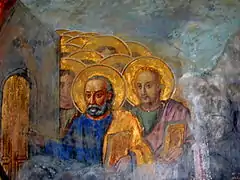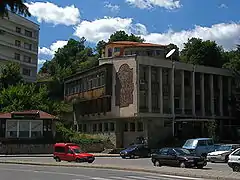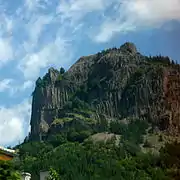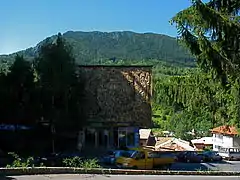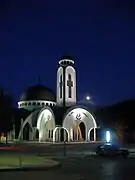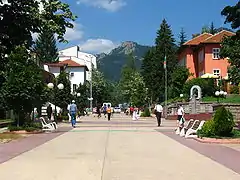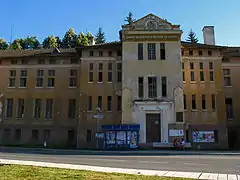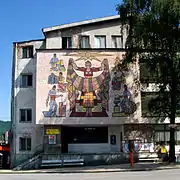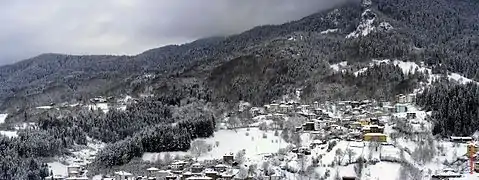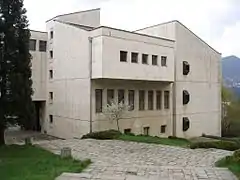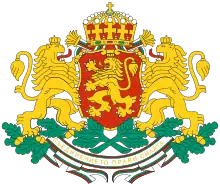Smolyan
Smolyan (Bulgarian: Смолян; Greek: Σμόλιαν) is a town and ski resort in the far south of Bulgaria near the border with Greece. It is the administrative and industrial centre of the homonymous Smolyan Province. The town is situated in the valley of the Cherna ("Black") and the Byala ("White") Rivers in the central Rhodopes at the foot of the mountains' highest part south of the popular ski resorts Pamporovo and Chepelare. As of February 2011, it has a population of 30,283 inhabitants.
Smolyan | |
|---|---|
 | |
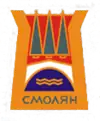 Coat of arms | |
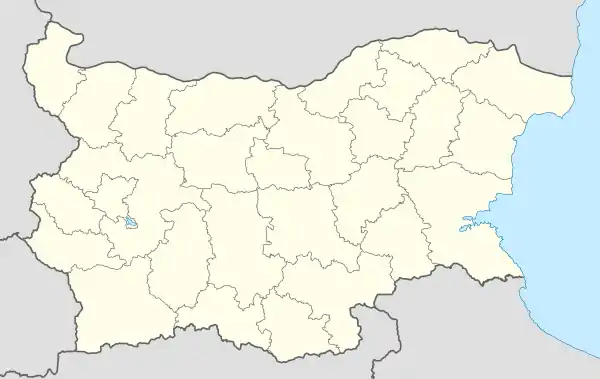 Smolyan Location of Smolyan | |
| Coordinates: 41°35′N 24°42′E | |
| Country | Bulgaria |
| Province (Oblast) | Smolyan |
| Government | |
| • Mayor | Nikolay Melemov (GERB) |
| Area | |
| • City | 134.59 km2 (51.97 sq mi) |
| Elevation | 1,002 m (3,287 ft) |
| Population (Census February 2011) | |
| • City | 30,642 |
| • Density | 230/km2 (590/sq mi) |
| • Urban | 41,452 |
| Time zone | UTC+2 (EET) |
| • Summer (DST) | UTC+3 (EEST) |
| Postal Code | 4700 |
| Area code(s) | 0301 |
| Website | www |
Name
The name of the town comes from the local Slavic tribe of the Smolyani, the name of whom is probably cognate to the Slavic word smola ("resin").[1]
History
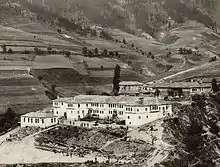
According to archaeological evidence, the area around Smolyan was first settled in the 2nd-1st millennium BC. In the Middle Ages it acquired its name from the Slavic tribe, the Smolyani, who settled in the region in the 7th century. During the Middle Ages, it was ruled by the Part of the Byzantine and Bulgarian Empires. For a while during the 14th century it came under the control of the Bulgarian feudal lord Momchil, alongside the whole Rhodope mountains, before eventually being subjugated by the Ottoman Empire. Smolyan remained under Ottoman rule for five centuries, a township of the Ottoman Sanjak of Gümülcine in the Adrianople Vilayet between 1867 and 1912. It was known in Ottoman Turkish as Paşmaklı or Ahiçelebi.
The area was liberated by the 21st Sredna Gora Regiment led by Vladimir Serafimov in 1912, during the First Balkan War. The modern town of Smolyan was formed by the merger of three existing villages — Ustovo, Raykovo and Ezerovo — in 1960.
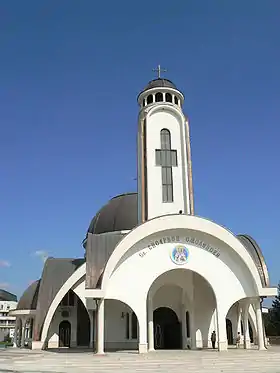
Population
The population of Smolyan just after World War II was about 5,000.[2] Since then, it started growing decade by decade, mostly because of the migrants from the rural areas and the surrounding smaller towns, reaching its peak in the beginning of the 1990s, exceeding 34,000.[3]
| Smolyan | |||||||||||||||
|---|---|---|---|---|---|---|---|---|---|---|---|---|---|---|---|
| Year | 1887 | 1910 | 1934 | 1946 | 1956 | 1965 | 1975 | 1985 | 1992 | 2001 | 2005 | 2009 | 2011 | 2013 | |
| Population | no data | no data | no data | 5,406 | 7,472 | 17,448 | 28,492 | 31,539 | 34,086 | 33,153 | 31,988 | 31,718 | 30,642 | 30,045 | |
| Highest number 34,086 in 1992 | |||||||||||||||
| Sources: National Statistical Institute,?? citypopulation.de,?? pop-stat.mashke.org,?? Bulgarian Academy of Sciences?? | |||||||||||||||
Ethnic linguistic and religious composition
According to the latest 2011 census data, the individuals declared their ethnic identity were distributed as follows:[4][5]
- Bulgarians: 25,045 (97.0%)
- Roma: 258 (1.0%)
- Turks: 153 (0.6%)
- Others: 120 (0.5%)
- Indefinable: 248 (1.0%)
- Undeclared: 4,818 (15.7%)
Total: 30,642
In Smolyan Municipality 32708 declared as Bulgarians, 301 as Roma and 170 as Turks and 9,000 did not declare their ethnic group.
Religion
In 1912, Aha Celebi said that 8,252 families already live, including 2,815 of Bulgarians Exarchists, 140 of Bulgarians Patriarchists and 5,297 of Bulgarian Muslims or Pomaks. (Lyubomir Miletich, "The Destruction of Thracian Bulgarians in 1913") In 1912, in the town live 320 families of Bulgarians Muslims, 80 of Bulgarians Exarchists and 40 Patriarchists.[6] In Ustuvo live 420 families Bulgarians Exarchists, in Raykovo - a total of 700 families of Bulgarians Exarchists, 100 of Bulgarians Patriarchists and 70 of Bulgarian Muslims. Currently, the religion of the majority is Muslim, the rest are mostly Bulgarian Orthodox or unaffiliated.
Culture and sports
Due to its suitable location on top of Mount Rozhen, the Bulgarian National Astronomical Observatory is located nearby, with a planetarium in operation in the town. There is one theatre, the Rhodope Drama Theatre, and a gathering of theatre practitioners and scholars known as The Rhodopi International Theatre Laboratory is held every summer. There is also a regional historical museum founded in 1935.
Smolyan has an elite division football team, PFC Rodopa Smolyan, that had been playing in the A Professional Football Group between 2003-2007.
The largest church in southern Bulgaria, the Cathedral of Saint Vissarion of Smolyan, was inaugurated in the city in July 2006.
Municipality
Smolyan is also the seat of Smolyan municipality (part of Smolyan Province), which includes the following 79 villages:
- Aligovska
- Arda
- Belev dol
- Bilyanska
- Borikovo
- Bostina
- Bukata
- Bukatsite
- Chamla
- Chepleten
- Chereshkite
- Chereshovo
- Chereshovska Reka
- Chokmanovo
- Chuchur
- Dimovo
- Dunevo
- Elenska
- Elyovo
- Fatovo
- Gabritsa
- Gela
- Gozdevitsa
- Gorna Arda
- Gorovo
- Gradat
- Gudevitsa
- Hasovitsa
- Isyovtsi
- Katranitsa
- Kiselichevo
- Kokorkovo
- Koshnitsa
- Kremene
- Kukuvitsa
- Kutela
- Laka
- Levochevo
- Lipets
- Lyulka
- Milkovo
- Mogilitsa
- Momchilovtsi
- Mugla
- Nadartsi
- Oreshitsa
- Ostri Pazlak
- Petkovo
- Peshtera
- Pisanitsa
- Podvis
- Polkovnik Serafimovo
- Poprelka
- Potoka
- Rechani
- Reka
- Rovina
- Selishte
- Shiroka Laka
- Sivino
- Slaveyno
- Smilyan
- Sokolovtsi
- Solishta
- Sredok
- Stikal
- Stoykite
- Sarnino
- Strazha
- Taran
- Tikale
- Trebishte
- Turyan
- Uhlovitsa
- Valchan
- Varbovo
- Vievo
- Vlahovo
- Zaevite
- Zmievo
Climate
Smolyan has either a warm-summer mediterranean climate (Köppen climate classification: Csb) or a dry-summer warm-summer humid continental climate (Köppen climate classification: Dsb), depending on if the 0 degrees celsius or -3 degrees celsius isotherm is used.
| Climate data for Smolyan | |||||||||||||
|---|---|---|---|---|---|---|---|---|---|---|---|---|---|
| Month | Jan | Feb | Mar | Apr | May | Jun | Jul | Aug | Sep | Oct | Nov | Dec | Year |
| Average high °C (°F) | 2.7 (36.9) |
4.5 (40.1) |
9.2 (48.6) |
13.6 (56.5) |
18.5 (65.3) |
22.2 (72.0) |
25.6 (78.1) |
25.7 (78.3) |
21.1 (70.0) |
16.3 (61.3) |
10.2 (50.4) |
4.1 (39.4) |
14.6 (58.3) |
| Average low °C (°F) | −5.2 (22.6) |
−3.4 (25.9) |
−2.1 (28.2) |
3.9 (39.0) |
7.7 (45.9) |
10.8 (51.4) |
12.8 (55.0) |
12.7 (54.9) |
8.8 (47.8) |
4.7 (40.5) |
1.1 (34.0) |
−3.8 (25.2) |
4.0 (39.2) |
| Average precipitation mm (inches) | 80 (3.1) |
70 (2.8) |
90 (3.5) |
90 (3.5) |
200 (7.9) |
100 (3.9) |
80 (3.1) |
30 (1.2) |
10 (0.4) |
90 (3.5) |
180 (7.1) |
210 (8.3) |
1,290 (50.8) |
| Average relative humidity (%) | 72 | 74 | 69 | 70 | 70 | 69 | 66 | 57 | 62 | 74 | 72 | 77 | 69 |
| Source: [7] | |||||||||||||
Honour
Smolyan Point on Livingston Island in the South Shetland Islands, Antarctica is named after Smolyan.
Notable people
- Victor Houteff, founder of the Davidian branch, an offshoot of the Seventh-day Adventist Church.
Gallery
References
- "гр. Смолян" (in Bulgarian). BGGLOBE. Retrieved 2008-09-14.
- „pop-stat.mashke.org“
- (in English) „WorldCityPopulation“
- (in Bulgarian) Population on 01.02.2011 by provinces, municipalities, settlements and age; National Statistical Institute
- Population by province, municipality, settlement and ethnic identification, by 01.02.2011; Bulgarian National Statistical Institute (in Bulgarian)
- По данни от „Разорението на тракийските българи през 1913 г.“ от Любомир Милетич
- "Weather Base". Weather Base. Retrieved December 21, 2012.
External links
| Wikimedia Commons has media related to Smolyan. |
